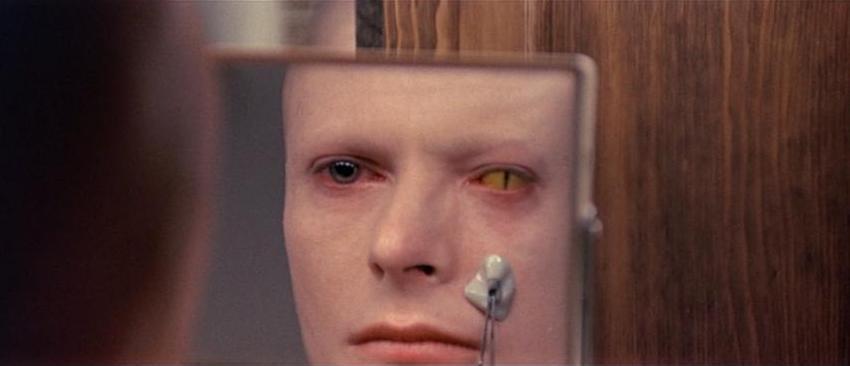Quality costume design in a well-executed movie can inspire generations of fashion collections, editorials, campaigns, and even a new look. In terms of innovation, no film genre is quite as compelling as science fiction. Sci-fi features aggressively stylized garments, and the world-altering and paradigm-shifting concepts needed to sustain them. When the costume designer gets it right, a film can influence fashion for decades to come. Here are ten of the best, in our exhaustive investigation of science fiction styles.
The Matrix (1999)
Sunglasses, a sweeping dark trench, patent leather skimming the body – all in black – it was a look that invaded popular culture on the cusp of the new millennium, influencing fashion designers and sci-fi geeks alike. The costumes of The Matrix were, for better or for worse, a cultural phenomenon that defined the era’s idea of cool. Borrowing notions of Helmut Lang’s relentless urbanism and a tinge of gothic romance a la early Olivier Theyskens, the look acted as a template for a modern day superhero.
Gattaca (1997)
A tale of a eugenics-ruled future, Gattaca was made in the midst of the ultra-minimal trend arc of the 90s. Costume designer Colleen Atwood reportedly recut suits from the 30s and 80s (sampling the 40s) in modern fabrics. There’s a retro romance within the extremely conservative sparseness that feels akin to Miuccia Prada’s fascination with the 30s. The look of the film, after 15 years, has aged pretty well.
Mad Max 2: The Road Warrior (1981)
The costumes of Mad Max, the cult franchise about a leather-clad cop trying to make order in the lawless outback, have become the standard by which any and all post-apocalyptic ambitions are measured. Mad Max 2: The Road Warrior defined the scavenged and wanderlust aesthetic that has since become synonymous with future doom. Norma Moriceau synthesized a new genre from the New Romantic fascinations of Vivienne Westwood, the fascism of Thierry Mugler and even deconstruction by way of Rei Kawakubo.
Star Wars: A New Hope (1977)
Set in a time long, long ago and in a galaxy far, far away, the universe of Star Wars presents a technologically advanced world that exists in harmony with ancient tradition. The draped garments of the Jedi are as vital and relevant in this galaxy as the white molded uniforms of the Imperial Storm Troopers. The range of designs and the depth of detail in the Star Wars films is so expansive, it’s no wonder that lauded designers such as Nicholas Ghesquière and Christophe Lemaire have openly referenced the film for inspiration.
Solaris (1972)
Tarkovsky wanted the costumes in Solaris to be timeless and dismissed most of the clichés of futuristic dress (he had particular disdain for Kubrick’s 2001: A Space Odyssey). The designs maintain a sense of warmth, dealing in classics like sweatshirts and twill trousers and crafted garments like a crochet shawl. Quiet but profound, they mirror the shift in fashion at the time as the craze for the space age died down and designers began to focus on a more humanistic approach.
Alien (1979)
H.R. Giger’s iconic “biomechanoid” creature design informs the film’s entire production design. The clothes for the crew of the Nostromo, a deep space towing vessel, are lived-in and soiled. The crew’s personal touches, like cowboy boots, or a Hawaiian shirt, make the costuming eclectic. The look could easily be achieved today by mixing Hood By Air with vintage. The best fashion moment is in a scene towards the end when Sigourney Weaver strips down to her skivvies and gives Calvin Klein models a run for their money.
The Man Who Fell To Earth (1976)
Orange-haired, gaunt, exotically English, Bowie is an alien on a mission to source water for his dying planet. Bowie’s unique gender-bending glamour is on full blast and sustained throughout a tragic drama worthy of Euripides. The Man Who Fell To Earth has since become an essential fashion reference. From Hedi Slimane (for whom Bowie is eternal inspiration), to J.W. Anderson for Loewe to Alessandro Michelle’s at Gucci, designers are actively questioning male gender norms and the film’s wardrobe provides urgent inspiration.
Blade Runner (1982)
This film is 80s fashion incarnate, a moving editorial for all the futurist trends of the era. Michael Kaplan’s costumes, with 40s film noir and overtly futurist elements, codified the fashion trends of the era from Montana to Mugler. Since, the designs have been referenced by everyone from Alexander McQueen to Raf Simons. The costumes for Blade Runner have entered the sci-fi fashion canon and are a highlight of the film’s dazzling visuals and art direction.
The Fifth Element (1997)
Luc Besson enlisted Paris’s enfant terrible Jean-Paul Gaultier to do the costumes for his 90s sci-fi epic. Known for his radical takes on gender, streetstyle, and ethnic dress, Gaultier was brought Besson’s utopic and cosmopolitan future to life. With over a thousand characters to dress, it would be Gaultier’s largest undertaking ever. From fast food employees, to cops, to flight attendants, to monks, to Chris Tucker’s post-gender and flamboyant Ruby Rod, to an alien opera diva, the costumes reveal Gaultier’s relentless imagination and awesome breadth.
2001: A Space Odyssey (1968)
Stanley Kubrick commissioned established London couturier and dressmaker to the Queen Hardy Amies to design the costumes for his interplanetary epic. Amies engaged the modern space-age look that prevailed at the time with an attention to detail and staging that would make even Pierre Cardin envious. Amies’s approach to couture and matter-of-fact sensibility translated into everything from work suits, to Pan Am uniforms, to streamlined men’s suits. Widely regarded as a visual benchmark for its production design, cinematography, and special effects, 2001 is not just an immaculate vision of the future, but the standard against which all other sci-fi designs are measured. It’s a window into an alternate vision of Amies’s fashion universe and probably some of the best clothes he ever designed.
Credits
Text Jeremy Lewis
